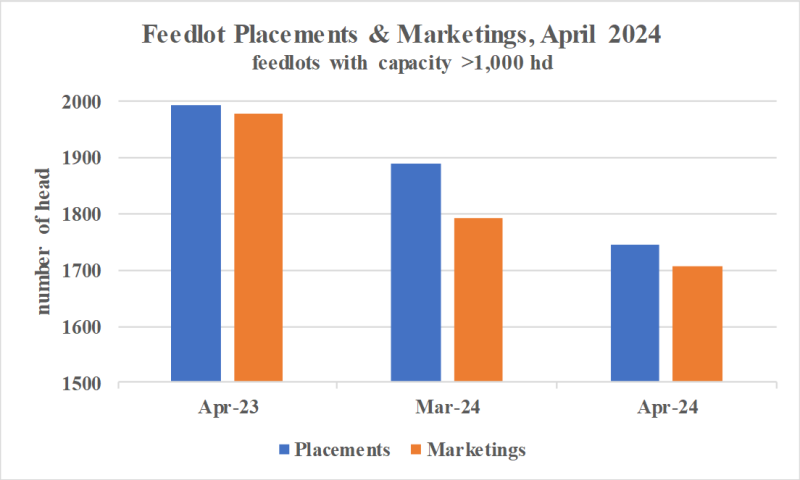Feedlot Happenings, Carcass Weights, & Beef Supply
It is no secret that supply of beef feeder cattle is low and is expected to be lower in the future, due to the beef cow herd being the lowest it has been in 63 years, with little signs that expansion has started. This in turn will affect beef supply in 2024 and years after. However, while beef supply is expected to be lower in 2024, recent forecasts from USDA are predicting that beef supply may not be as low as expected compared to forecasts at the beginning of the year and last year. In this update, we will break down what is going on in feedlots to explain why the 2024 forecast has increased.
The total number of cattle on feed in March reached 11.82 million head, up 1.5 % since 2023. What is interesting though, is placements were down by 12.3% during the month of March. So how is it that we have more cattle on feed than a year ago with less feeder cattle going into the feedlots? Placements were down, but marketings (cattle leaving the feedlots) were also down by 13.7 percent. This indicates that feedlots are feeding cattle longer to increase fed cattle weights. Right now, feeder cattle are expensive but the price to feed feeder cattle has been declining. With this combination, feedlots are holding cattle longer in an effort to increase their chances of making a positive return when selling heavier weight cattle. With the expected decline of feeder cattle supplies, feedlots are trying to delay the inevitable of not being able to maintain capacity.
As a result of holding cattle for more days, steer carcass weights reached 923 pounds, up 2.7% year-over-year in March. Heifer carcass weights reached 847 pounds, up 2.2%t year-over-year. The average dressed carcass weight of all cattle reached 846 pounds, up 2.8% year-over-year. With carcass weights reaching these levels, the latest forecast from USDA is that beef production will reach 26.5 billion pounds in 2024, still 1.9% lower than 2023. However, this forecast is 1.3% higher than the forecast made in January 2024, and 4.7% higher than the one made in October 2023. Another factor contributing to beef supply is that heifers are still being sent into feedlots rather than being retained. As of April, 38.5% of all cattle on feed were heifers. This is a slight decline from January 2024 and October 2023, but not enough to confidently say expansion has started. During the last expansion period (2015-2017), the percentage of heifers on feed averaged at about 33%. So, while beef production is expected to decline, supplies are not currently forecast to be as tight as previously expected for 2024.
Questions, contact Hannah at h.baker@ufl.edu
See this update and other helpful resources online at https://rcrec-ona.ifas.ufl.edu/about/directory/staff/hannah-baker/
- April 2024 Florida Cattle Market Update - May 3, 2024
- March 2024 Florida Cattle Market Update – Current and Future Feedlot Inventories - April 5, 2024
- Cattle Market Update:Bi-Annual Cattle Inventory and Market Report - February 9, 2024


